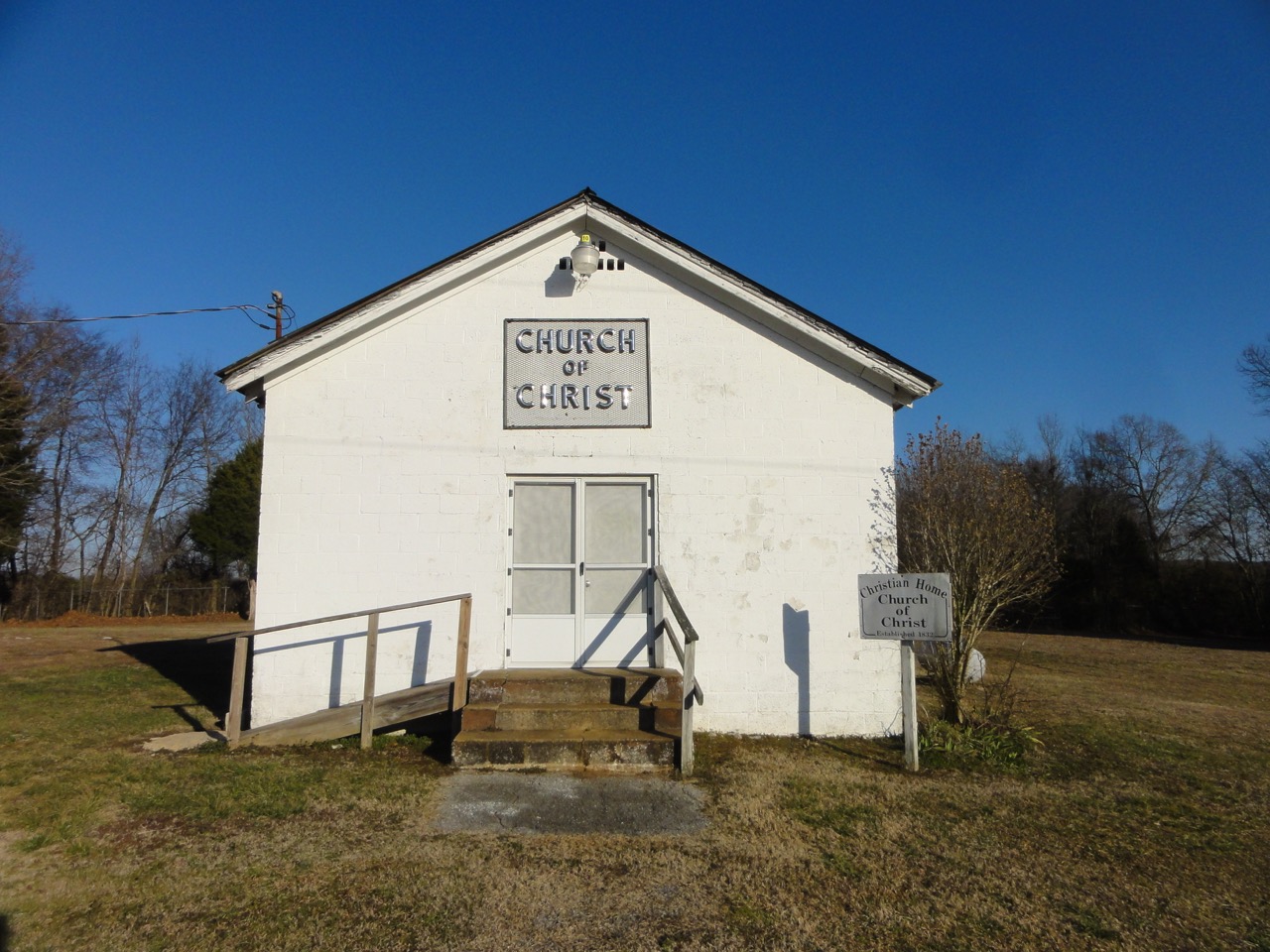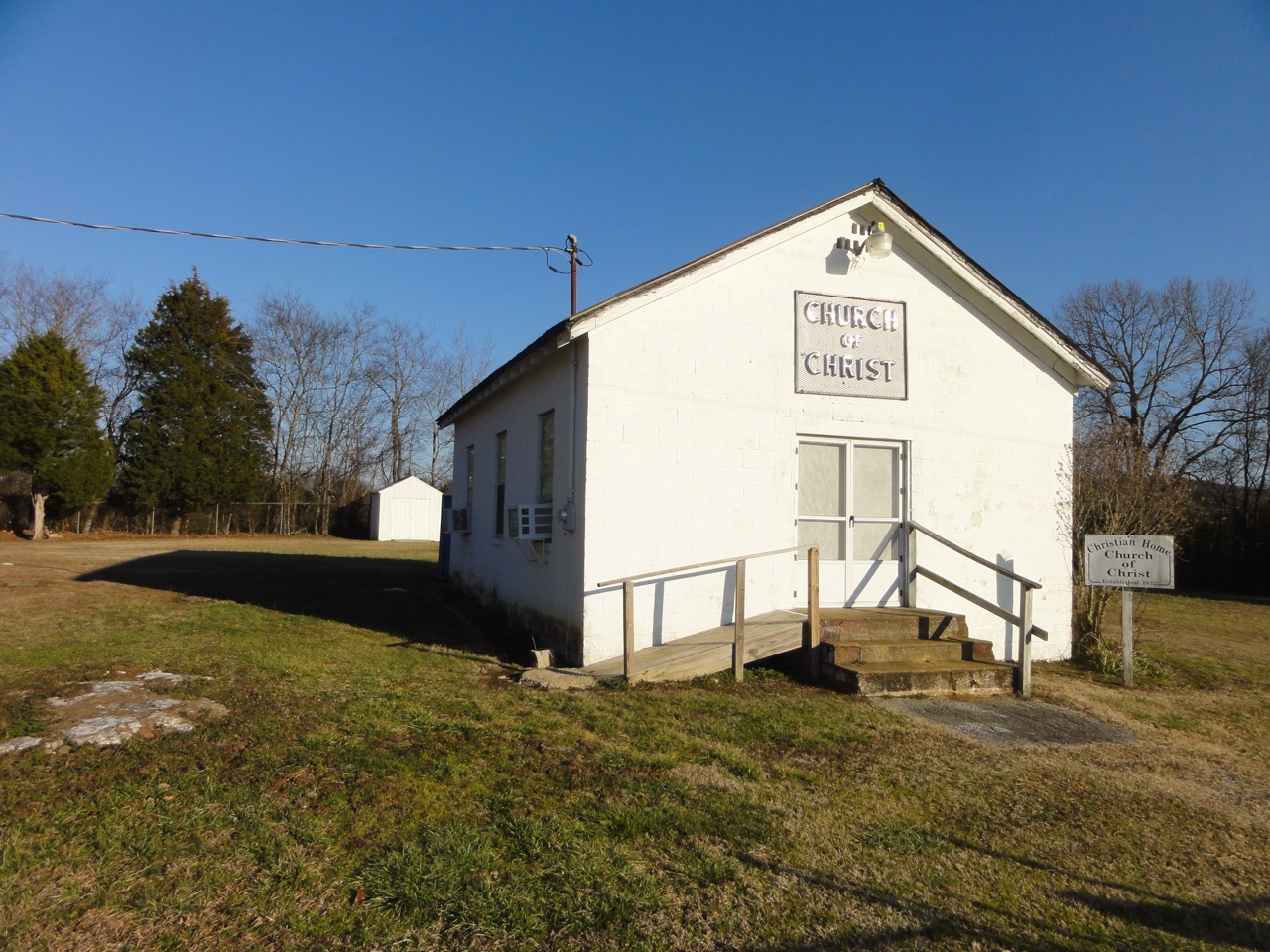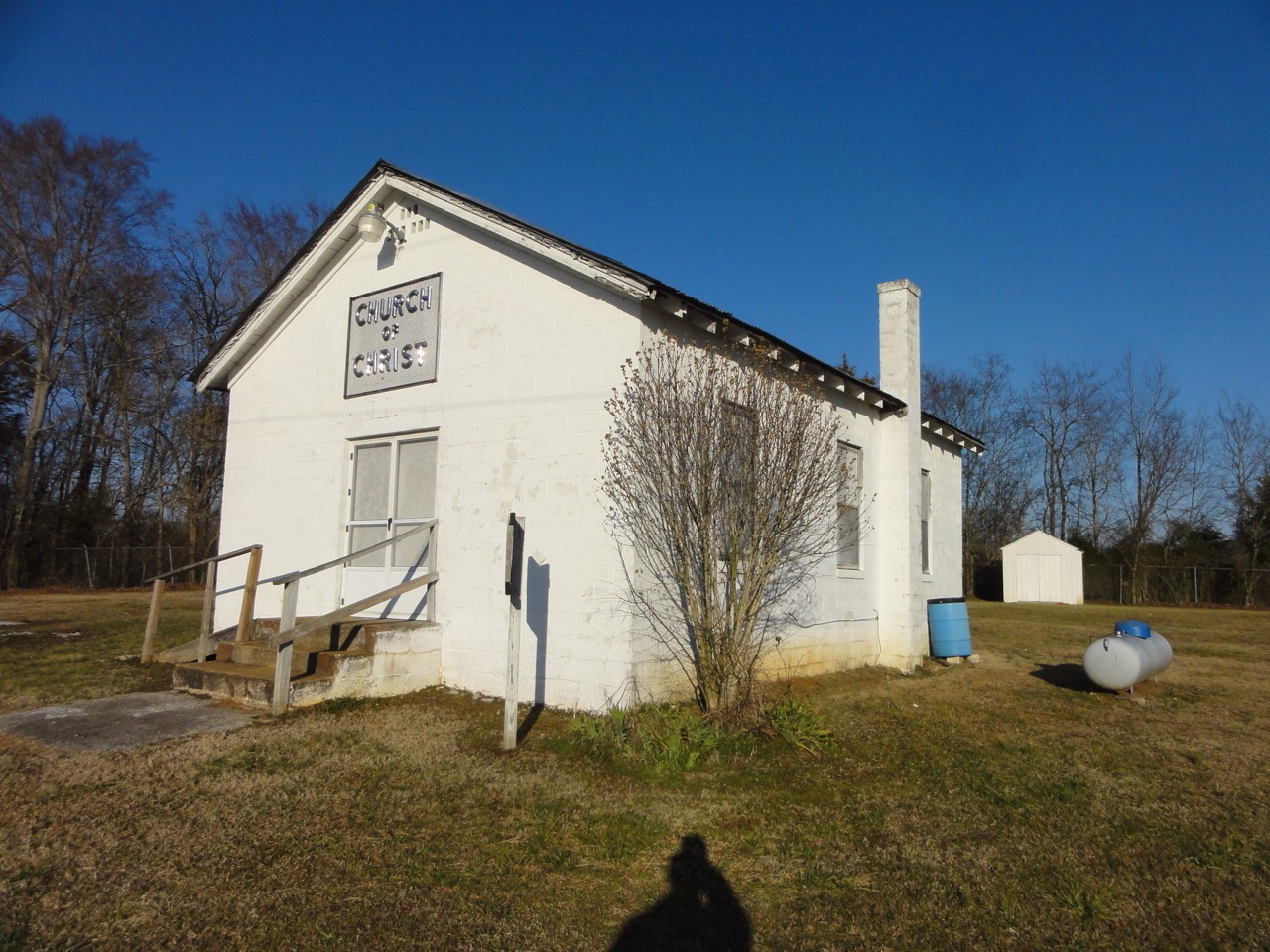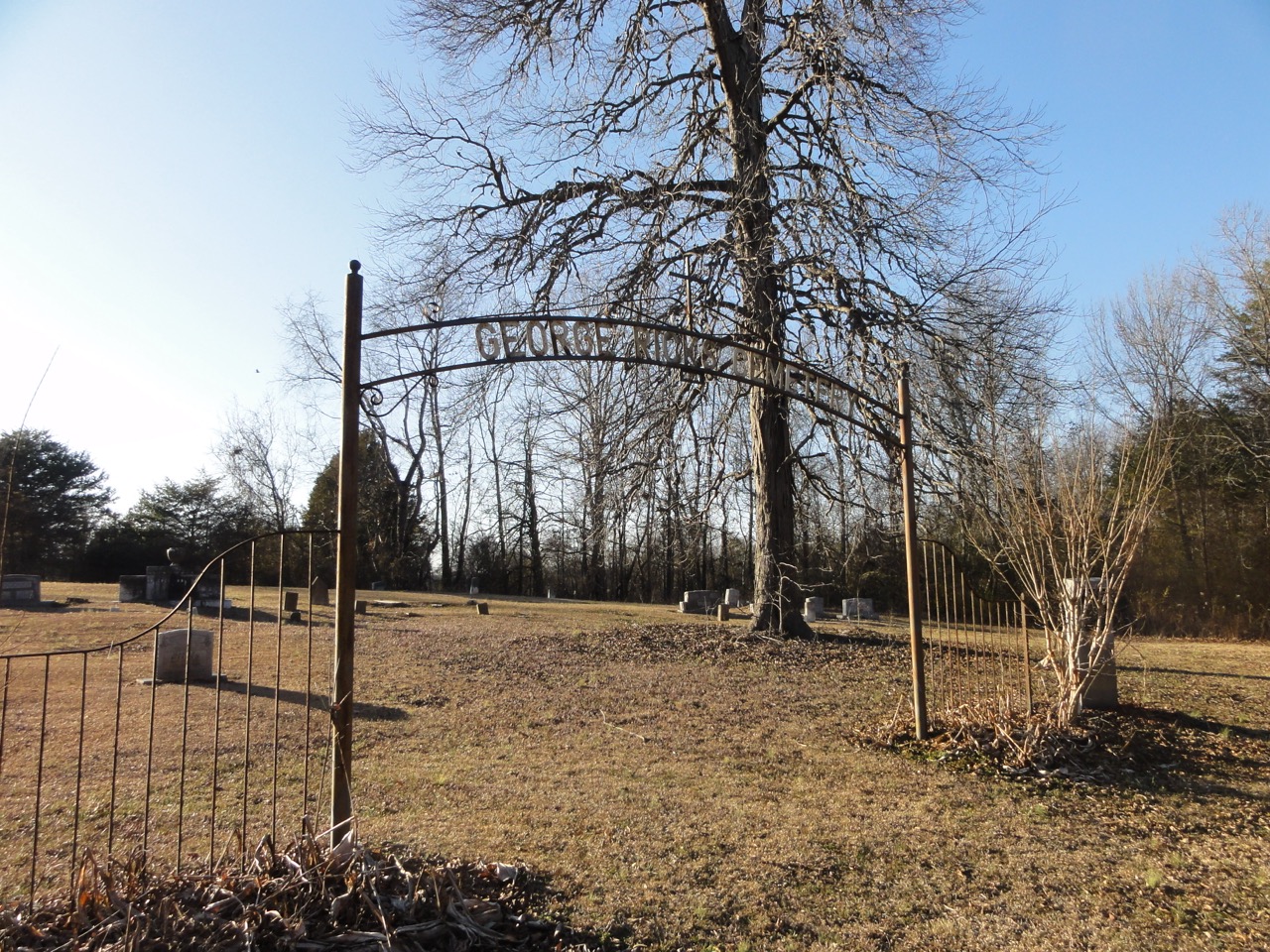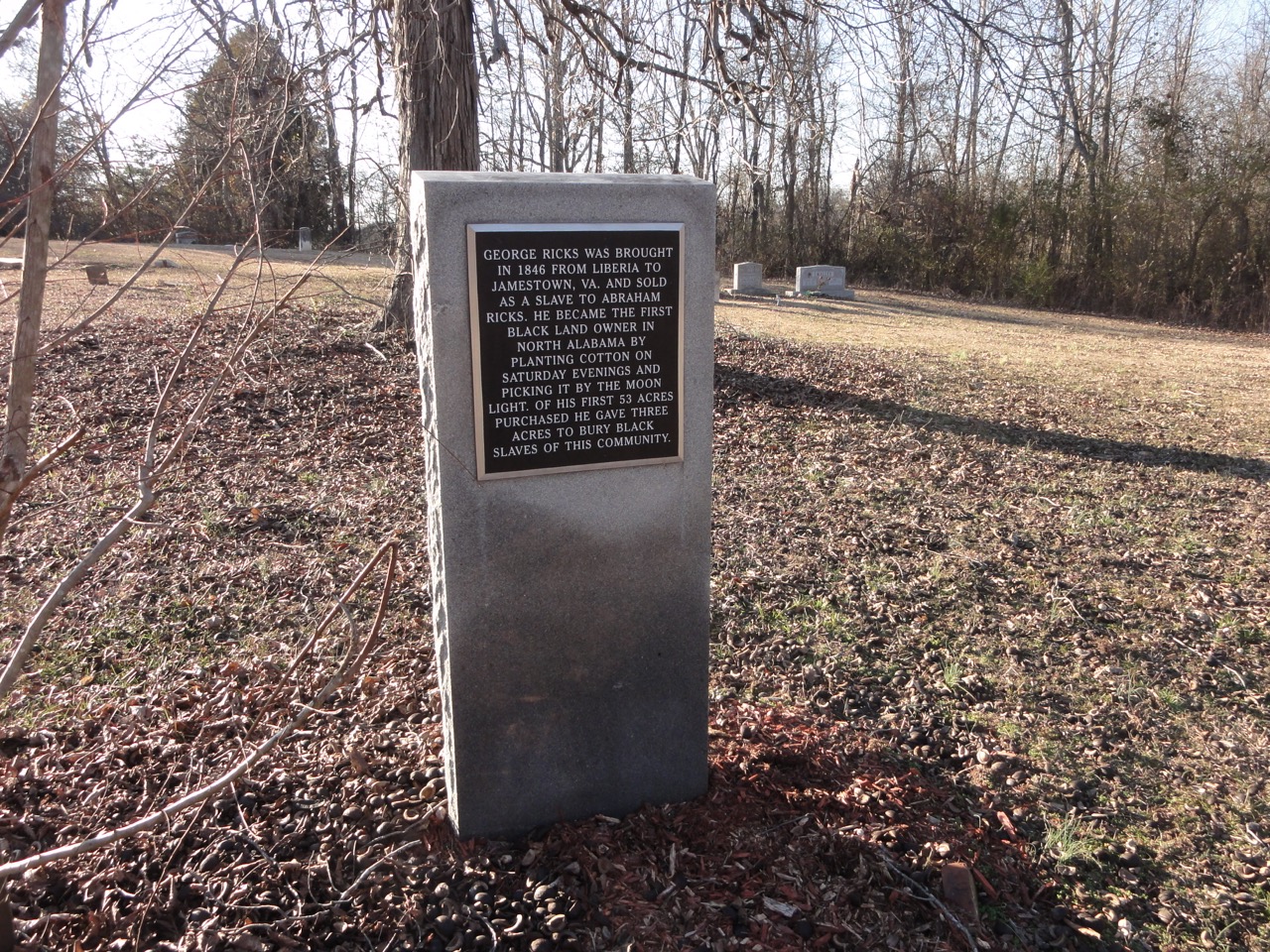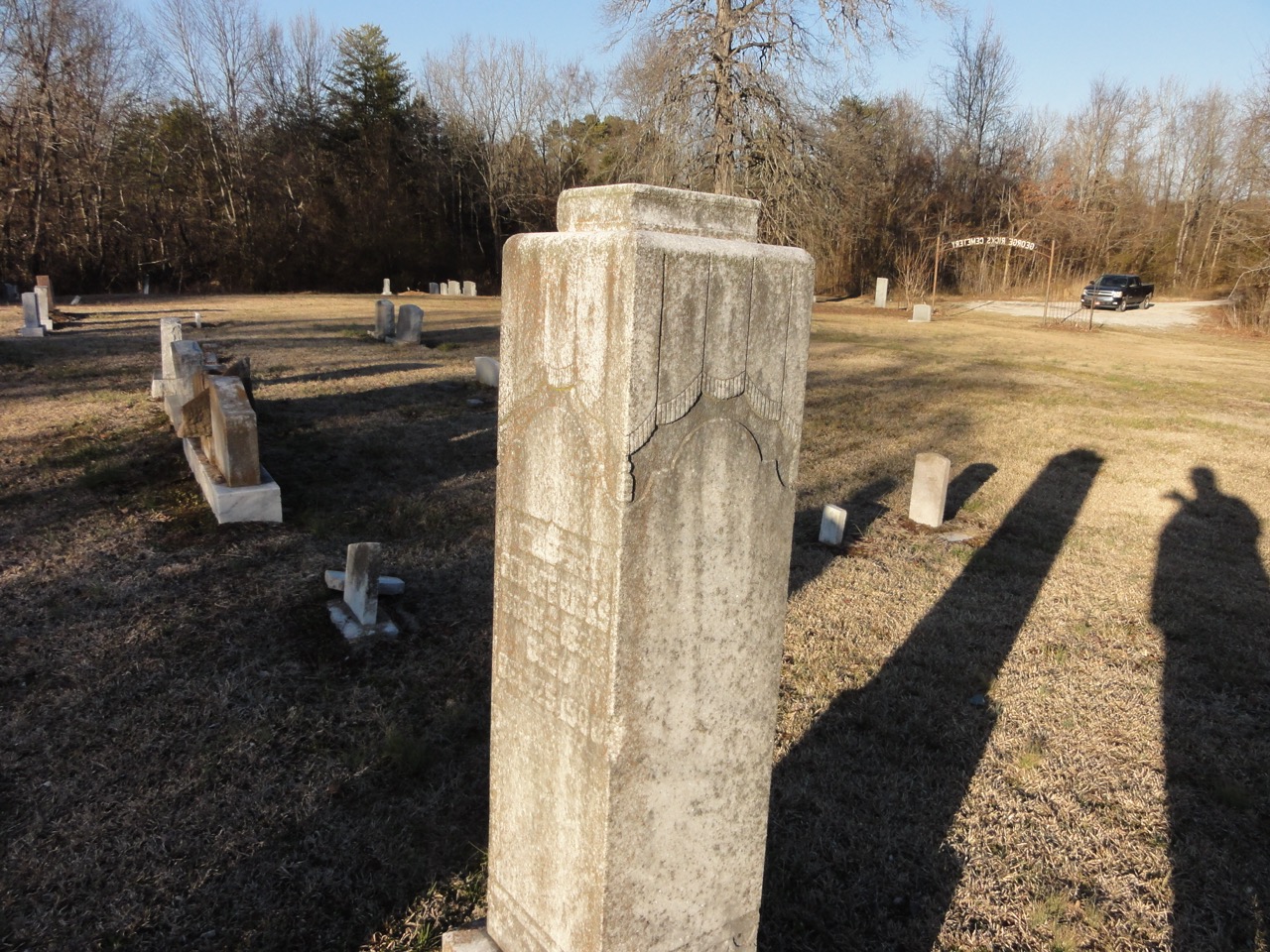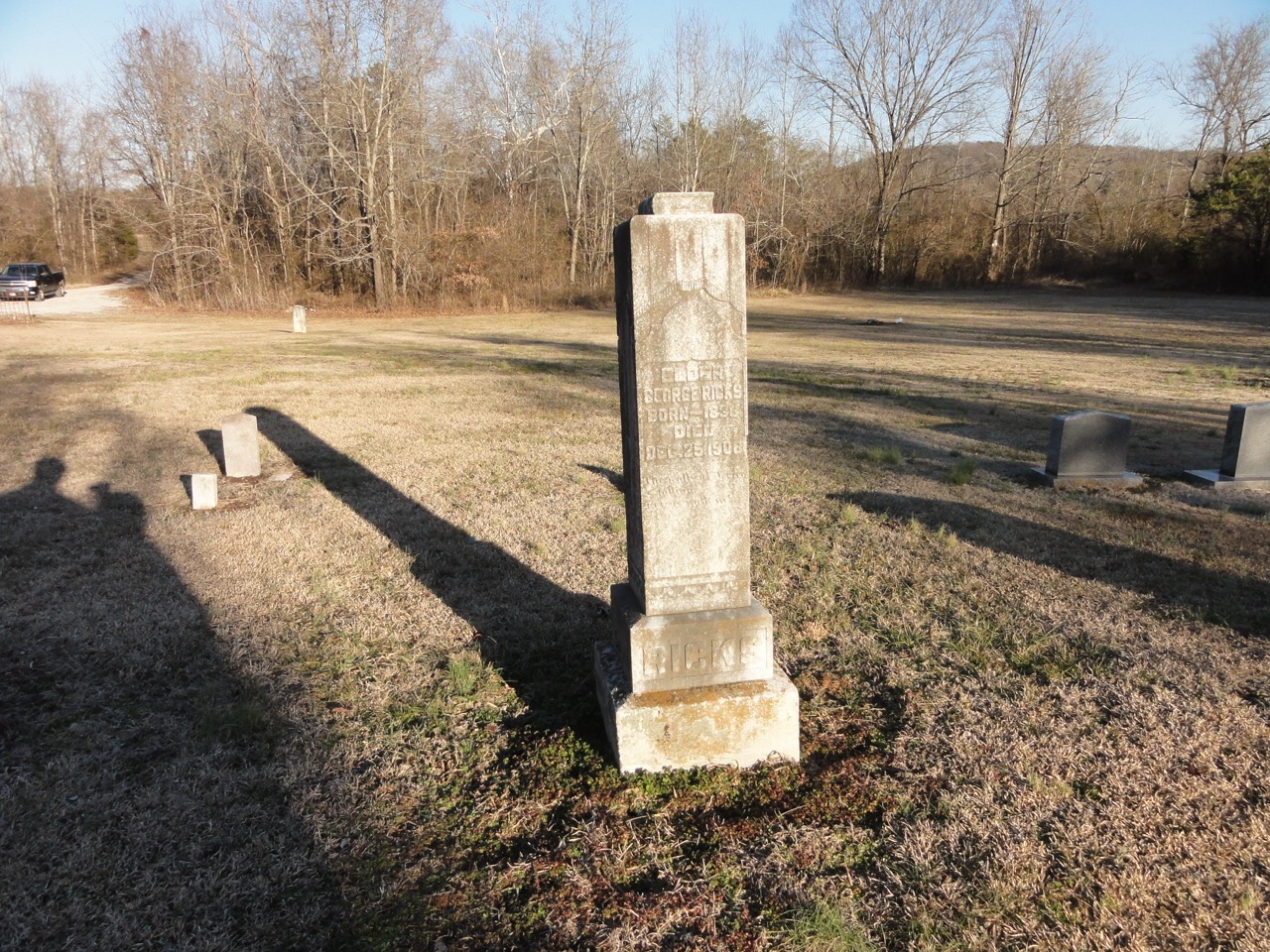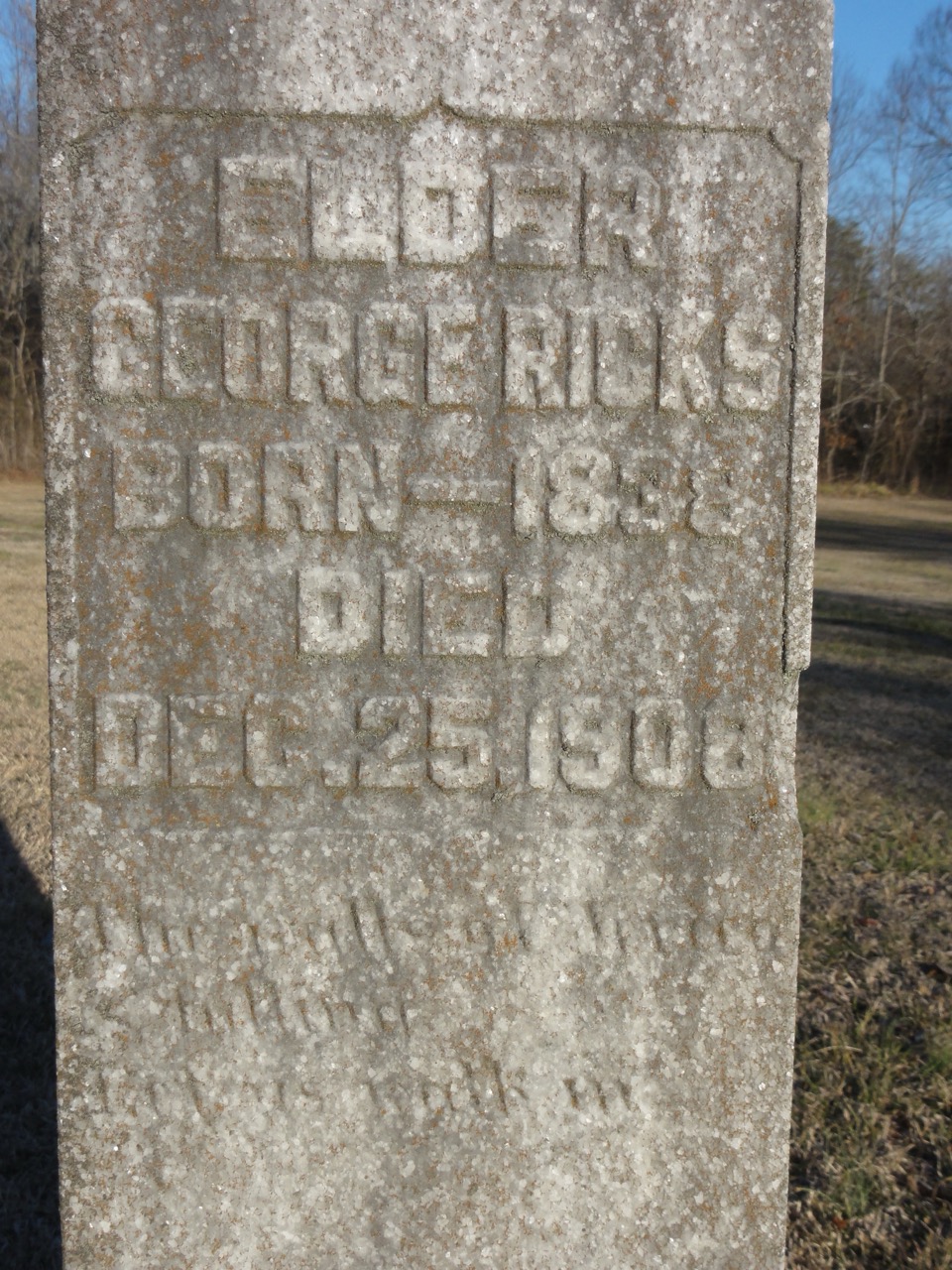Elder George Ricks
1838-1908
![]()
"Parson" George Ricks
The story of “Parson” George Ricks is one of a man overcoming almost insurmountable odds. George Ricks was born a slave and died a landowner, respected citizen, and admired gospel preacher. George was born in 1835, sometime after his master, Abraham Ricks, moved into what is now Colbert County, Alabama, and began construction on his plantation, in the Spring Valley community known as “The Oaks.”
Abraham Ricks was born October 16, 1791, in Halifax County, North Carolina. He married his first cousin, Charlotte B. Forte. Abraham and Charlotte Ricks moved to Alabama about 1820 with thirty other families, bringing all their possessions including slaves. For awhile, they lived in Lawrence County, Alabama, and then moved to Colbert County in 1825. At this time, Ricks began construction of his plantation home, “The Oaks.” The house was completed in 1832 and stands today as an example of an early plantation home. Abraham Ricks owned about 10,000 acres of land and 300 slaves. He was also the principal owner of a new investment at that time—a railroad. The Tuscumbia, Courtland & Decatur Railroad was the first railroad in the south. Stretching about forty miles from Tuscumbia to Decatur, this railroad served the need for transportation between the communities where river traffic on the Tennessee River was impossible due to the shoals in the Tennessee River between Elk River and Cypress Creek.
Abraham Ricks was a Christian, having obeyed the gospel before coming to Alabama. Evidently interested in spiritual matters, Abraham provided for the slaves on his plantation an opportunity to develop spiritually and to worship God without hindrance from outsiders. His son, Abraham Ricks, Jr., was sent to be educated by Alexander Campbell, at Bethany College in Bethany, Virginia. He was graduated “First Class of Merit” in 1848. He was a classmate of the famous gospel preacher, J. W. McGarvey.
Ricks was concerned about the treatment of slaves on his property. His granddaughter, Miss Bertie Ricks, reminisced about her family at “The Oaks” in an article published in 1936, written by Shartie Lane. Miss Bertie Ricks lived at “The Oaks” until her death in 1960. She stated that her grandfather “was a kind man and a level headed practical business man.” She said he was “a lenient master and his servants were devoted to him. He had overseers about the plantation but he never allowed them to whip the slaves.” She said her grandfather did whip one slave for brutally beating his wife and another who threatened his (Abraham Ricks) wife, Charlotte. She said “my grandfather never separated a man and his wife and my father never sold any of his slaves.” Bertie Ricks also stated that the slaves “were all well fed, clothed and housed. The old plantation used to ring with their laughter and their songs. And they were happy for many of them have told me so. Indeed one old man cried when freedom came and begged my father not to free him.” She also said that Abraham Ricks gave each of the slaves “an acre of ground to make a crop of their own and to do with the proceeds as they pleased.” This is said not to justify slavery, but to point out that slaves at “The Oaks” fared much better than the slaves on most other plantations. Charlotte Ricks was a special lady. She was described as an unusually lovable character and an angel of mercy. Her obituary appeared in the March 26, 1874 issue of the North Alabamian newspaper (whose editor was Captain A. H. Keller, father of Helen Keller) and was one of the longest obituaries ever printed by the paper. The article spoke extensively of her love for and ability to grow flowers. The obituary went on to say, “She was truly a ministering angel to her family and friends, possessing a mind unusually bright, a clear judgment, and a heart that knew not evil. Every virtue found a home in her heart, and made her loved and lovely.” The obituary extolled her virtues in many areas, including hospitality, stating: “For two generations her name has been the synonym of hospitality in this community. And where has such hospitality ever been excelled?”
Charlotte Rick’s concern for others extended to the slaves on the plantation. Her granddaughter said, “Many of our servants were taught to read and write. My grandmother would teach the little house Negroes the Catechism on Sundays after she had sent them home for their mothers to bathe and dress them.”
It was probably in these Bible classes that a young George Ricks developed a love for the Word of God and determined to become a gospel preacher. Later, as a man, George Ricks would become a leader in the black community, loved and respected by both races. George probably learned to read and write at the feet of Charlotte Ricks.
A church was built on the plantation for the slaves. It is not known when the church at The Oaks began. The sign in front of the present building states 1832. If this is the case, the Christian Home Church of Christ is the oldest church of Christ in Colbert and Franklin County. (Franklin County was divided into Colbert and Franklin after the Civil War.) This would also be one of oldest churches of Christ built by and owned by black brethren anywhere in the country. There is evidence that the slaves were meeting on the plantation in the years prior to the Civil War. However, the first known meetinghouse was a log building built by Abraham Ricks, Jr. This building would have probably been built after the death of Abraham Ricks, Sr. in 1852.
George Ricks was a hard worker. A marker at the Ricks Cemetery where George is buried states that he was “a slave to Abraham Ricks (and) he became the first black land owner in North Alabama by planting cotton on Saturday evenings and picking it by the moon light.” He sold his cotton and with the proceeds bought fifty-three acres of land. His landholding would increase by another seventy acres. He was the first African-American to pay property taxes in Franklin County, Alabama.”
George Ricks’ love for the truth motivated him to preach the gospel. Brother Ricks traveled extensively to preach, riding on a bay mule to preaching appointments. Some of his preaching appointments were over one hundred miles away. The History of the Tuscumbia Church of Christ stated that “Parson” George Ricks, in 1880, “preached for the Rock Creek Church of Christ, near Tuscumbia, Alabama.” This is the church that had its beginning in 1868 under the influence of James and Sarah Srygley, the parents of F. B. and F. D. Srygley, famous preachers after the Civil War. This would have been highly unusual for a black man to preach in a “white” church. Evidently, Ricks was so respected among the white brethren that he was allowed to preach the gospel in their churches.
On many preaching trips, George was usually accompanied by Albert Eggleston. When asked why he went with brother Ricks, Eggleston said that George was a plain spoken man and feared that George might be attacked by his hearers. Eggleston said, “I went along to do his fighting for him!” Although Eggleston heard the gospel preached many times, he never obeyed it. He did request that Marshall Keeble, a very well-known black preacher in churches of Christ, speak at his funeral. Keeble honored his request, coming to the CME church in Tuscumbia, Alabama, to speak at his funeral. Mr. Eggleston died in 1950 at about the age of 100 years.
“Parson” George began preaching about 1867 or 1868. At this time, the church meeting on “The Oaks” was undergoing a financial crisis. Even though Miss Bertie Ricks reported that her father, Abraham Ricks, Jr., had built the building, there must have been indebtedness for the building materials owed by the members of the Christian Home Church of Christ. The Ricks family experienced economic devastation from the war. Mrs. Charlotte Ricks told how the Yankees had taken off all her mules and horses. She said Abe (Abraham Ricks, Jr.) was plowing with steers while she had nothing with which to plow, but intended to put her cows to the plow as soon as she could get them broke to the plow. Charlotte Ricks said she might as well laugh as cry over her troubles. The slave labor was gone and also the work animals. A once profitable plantation of 10,000 acres was reduced to what could be plowed by family members without animals broken to the plow. In these hard economic times, cash was hard to come by.
This scarcity of cash and probable “call of debt” prompted “Parson” George to take the leadership in securing money to pay off the debt on the church building. On December 20, 1867, he wrote a letter soliciting help to pay for the newly constructed house of worship on the old plantation. He asked a Christian, Dr. Edmund Chisholm of Tuscumbia, brother of Dr. L. C. Chisholm (who had recently moved to Nashville, Tennessee), to help him write the letter, which was printed in the January 2, 1868 issue of the Gospel Advocate is as follows:
Letter from a Colored Brother—Help Wanted. Tuscumbia, Ala., Dec. 20, 1867.
Dr Chisholm: —After saying howdy to you, I will state that I am doing very well, preaching at my old mistress Ricks’, and have about fifty members, and at my last baptising (sic), which was this day three weeks ago, I baptised (sic) three members into the church of Christ. So you see we are well with the excepting of need of money. We have not yet paid for our church-house. Supposing that a there may be some colored brethren in the vicinity in which you live belonging to the Christian ranks, who are not so poor as we are, and who are willing to devote a small amount, be it ever so little, I write to give you the fact that we are in need of money to pay the amount we are behind on our church-house. Will you please show this also to the white brethren—Brother Fanning and others, and ask their aid in the matter? If you can do anything for us, we will be thankful. Howbeit, let me hear immediately, say by Christmas, what you have done for us.
Direct your letter to me in care of your brother, Dr. Ed. Chisholm, at Tuscumbia. We are obliged to raise as much as twenty or twenty-five dollars by Christmas, if we possibly can. I hope and trust you will be successful enough to do it. Yours in Christ, George Ricks
David Lipscomb immediately responded by writing:
We have the assurance from Brother Chisholm and others that Brother Geo. Ricks is a most worthy, unassuming brother, and is doing a good and faithful work for the Lord and his people. We learn the Church at Franklin College has furnished Brother George with the amount he asks for immediately, but other small remittances, as above, to Dr. E. Chisholm would be most worthily appropriated. We are very anxious to aid all efforts to Christianize and elevate the negro and prepare him for living usefully here and hereafter.
“Parson” George is mentioned again in the Gospel Advocate, this time in the April 29, 1885 issue. He was visiting or preaching in the Nashville area and came by the Gospel Advocate office. Brother Lipscomb wrote:
Eld. Joe (sic, evidently meant Geo.) Ricks, (colored) of Spring Valley, Ala., gave us a call last week. He has been preaching about seventeen years during which time he has baptized about 300 hundred (sic) persons. His home congregation, Christian Home, Colbert county (sic), Ala., numbers 96 members and besides him there are six preachers. There is also a church at Fayettville, Talladaga county (sic), with 49 members that Bro. Ricks has been mainly instrumental in building up.
From humble beginnings, the little church on The Oaks plantation grew from Bible classes taught by Charlotte Ricks to the point of having a building in which to meet. When George Ricks gave an acre of his property to the church for the construction of the building, the Christian Home Church of Christ had a place to meet. Miss Bertie Ricks said in the article:
Later, sometime before the Civil War, my father built a little log church for his Negroes and as it was the first church of that kind established among the Negroes they named it the ‘Mother church’ and those that have been established since are called the ‘Branches.’ My father let his servants hold their services to suit themselves. They could preach, shout and sing as much as they wished so long as they conducted themselves with decorum and no one was allowed to molest them or to go there in derision. The land was donated by a slave of my father’s who accumulated quite a bit of property nearby after the war. Taught by my father as best he knew, this Negro was the preacher until his death and was much revered among his own people and highly respected among the white.
This much revered and highly respected Negro preacher was Parson George Ricks. A man, who by hard work, secured his own property, gained an education, and became a gospel preacher. George Ricks traveled a great deal, preaching among the black people, converted several hundred, and influenced thousands for good in his lifetime.
The building of the Christian Home Church of Christ was also used as a gathering place for the residents of the community and as a schoolhouse for many years, where grades kindergarten through the ninth grade held classes. Ms. Opheia Coffee served as teacher before 1931. In that year, Ms. Beatrice Sykes became the teacher. After a couple of years, Virginia Mayes became the teacher. In 1934, Lozzie Steele came and taught for one year. Lastly, Joe Griffin’s mother taught until 1937 when the school closed. Some of the students of the Ricks School were Sadie Cobb (future wife of Huston Cobb and elder at Westside Church of Christ, who assisted in this research), Abie Sledge, Frankie Mullins Davis, Alfred Mullins, Gladys Mullins, Marvin Ricks, Susan McClam, J. B. and Ellis Marvin, George D. Sledge, Rosie Vinson, Emma Jean King-White, Mattie Crawley-Gunn, and Otelia Long.
In the 1940s, the old log cabin where the saints met at the Christian Home Church of Christ was showing signs of age. The floors rotted and time, termites, and weather took a toll on the old building. Brother Fred Ricks, Sr., with the help of his son, Fred, Jr., and his daughters, Mildred Ricks Smith and Lois Ricks King, began to gather rocks and stones from nearby fields to raise the floor. Then concrete was poured for a more permanent foundation. Percy Ricks, Fred Ricks, Sr., Fred Ricks, Jr., John Lee Ricks, and Rave Randolph worked to build the block structure that stands today. The old building’s roof and ceiling were retained in the new structure.
Brother T. W. Rucks (1896-1984) carried on services every 4th Sunday after leaving High Street church of Christ in Tuscumbia, Alabama. Brother Rucks was born in Wilson County, Tennessee, and attended public school in Lebanon, Tennessee. He attended Nashville Christian Institute and later attended International Bible College. He began his preaching career in Nashville in 1920. He moved to Florence, Alabama, and in 1933 became the minister of the East Alabama Street Church of Christ, which is now the Westside Church of Christ. Brother Rucks also served as minister at High Street, Christian Home, Cherokee Church of Christ, and Reedtown Church of Christ. He continued to preach at Christian Home until his death. He would catch the bus in Tuscumbia and travel to the old store on Highway 20, and brother Fred Ricks, Sr. would meet him in a wagon pulled by a team of mules and bring him to the building at Christian Home.
When brother Rucks died, the services at Christian Home Church of Christ ceased. However, the church has begun to meet again in recent years, with John Smalley as the preacher. Brother Smalley’s wife, Delores Long Smalley, is a direct descendant of “Parson” George Ricks. Another descendant of George Ricks, Percy Ricks, helped this writer with research for this story.
From his labors in establishing and building up the Christian Home Church of Christ in the Spring Valley community of Colbert County, Alabama, on what is known as “The Oaks” plantation, several churches of Christ have been established in North Alabama. So many churches came from the Christian Home Church of Christ that Christian Home became known as The Mother Church. The Mother Church gave birth to several congregations. These include High Street Church of Christ in Tuscumbia, Cherokee Church of Christ in Cherokee, Sterling Boulevard Church of Christ in Sheffield, Westside Church of Christ in Leighton, Reedtown Church of Christ in Russellville, and a church at Fayetteville in Talladega, Alabama.
When “Parson” George died, an obituary appeared in The Leighton News, Friday, January 1, 1909. The obituary said:
Rev. George Ricks,
A Tribute to a Faithful Colored Man. Rev. George Ricks, colored, seventy-three years of age*, died December 25, 1908. As the angels of God sang out on the Christmas air, ‘Glory to God in the highest, and on earth peace, good-will toward men,’ the summons came to him—“Come unto me, all ye who are weary and heavy laden, and I will give you rest.
He laid down his cross and took up his crown. Parson George, as he was familiarly known, like Joshua, was a good fighter for the right. His characteristics were honesty, truthfulness, generosity, freedom of religious thought, and faith in the eternal God. Early in life, he began work in his Master’s vineyard. He was never happier than on the Sabbath days when he could gather his people together to sing the songs of Zion and tell of Jesus and His love.
He has sung his last doxology, but to his flock and large family of sons and daughters, weep not, but walk in his footsteps, so on the other shore you may clasp hands and sing hallelujah.
“Parson” George Ricks was a great servant of God. From humble beginnings to highly respected community and church leader, George Ricks is a man to whom honor is due. *According to the obituary, George Ricks would have been born in 1835. However, his tombstone states that he was born in 1838.
-Frank Richey, Vignettes of Virtue, Chapter 24 “Parson George Ricks,” c.2010, pps.71-80, pps.198 -208
Note: Frank Richey's book, Vignettes of Virtue, is a great book on several works and people in the early Restoration Movement. Order your copy today at: Vignettes Of Virture.
![]()
Directions To Grave
The George Ricks Cemetery is located in Leighton, Alabama.
From Birmingham, Alabama: Head north about 49 miles on I-65 to Cullman, Alabama. Take Exit 310, Hwy. 157 and head NW 53 miles toward Moulton. Turn left on J. McGee Rd. Go 1.6 miles and turn left on Ricks Cemetery Rd. The cemetery is at the end of the road. The grave of Elder George Ricks is in the middle of the cemetery. The GPS location below is of the grave location.
From Nashville, Tennessee: Head south on I-65. Crossing the Alabama state line, go to Decatur Exit 340A (AL-20) toward Decatur. Go 4.6 miles. Turn right on Hwy. 72 ALT. Travel 36.6 miles and turn left on Ricks Ln. Go one mile. (Note: the Ricks plantation home "The Oaks" on the right, and then the old "Church of Christ" where George Ricks preached on his left. At the end of the road turn right on Ricks Cemetery Rd. The cemetery is at the end of the road. The grave of Elder George Ricks is in the middle of the cemetery. The GPS location below is of the grave location.
GPS Location of Grave
34°39'42.3"N 87°35'35.0"W
or D.d. 34.661735,-87.593063
![]()
ELDER
GEORGE RICKS
BORN - 1838
DIED
December 25, 1908
![]()
Photos Taken 02.05.2015
Webpage Produced - 01.19.2024
Courtesy Of Scott Harp
www.TheRestorationMovement.com
Special Recognition: Thanks to C. Wayne Kilpatrick for introducing the wonderful life of Elder George Ricks to me when I took his Restoration History class in 1986. Several visits to the plantation and cemetery over the years. Also, to Frank Richey for his excellent article on the life of Elder Ricks. It was taken from his book, Vignettes of Virtue. Order your copy today!
![]()

